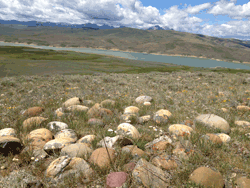New Easement Closes in the High Divide
 |
| Buhler family pose for a photo on their ranch near Monida, Mont. |
The Natural Resources Conservation Service (NRCS), in cooperation with the Nature Conservancy in Montana and the Centennial Revolving Loan Fund, closed a 4,100 acre conservation easement on the Buhler ranch near Monida, Mont.
The ranch encompasses important, intact stretches of high elevation sagebrush grasslands with a series of intermixed wetlands. The combination creates ideal nesting conditions for long-billed curlews, sandhill cranes and Greater sage-grouse. It is especially important for sage-grouse, a bird that was a recent candidate for the endangered species list.
“This outstanding easement would not have been possible without the strong partnership between The Nature Conservancy, the landowners and the NRCS," said Lisa McCauley, NRCS Easement Specialist for Montana. “The easement will limit development, preserving the native sagebrush grassland habitat.”
The native sagebrush grasslands on the ranch support a suite of other wildlife including pronghorn, elk, wolf,
 |
| Photo of landscape at the Buhler Ranch. |
bear, and pygmy rabbit. The land is also part of a critical connection for animals that must move between the Centennial Valley and Italian Peaks. By granting this easement, the Buhlers have joined the ranks of other conservation-minded ranchers in the region who have protected their lands while maintaining both profitable and environmentally sustainable livestock operations. Cumulatively, their actions are essential for species such as Greater sage-grouse, which need a lot of intact habitat to survive.
NRCS provided funding for the easement through the Farm and Ranchland Protection Program (the predecessor to the new Agricultural Conservation Easement Program), which is designed to protect the agricultural use and conservation values of eligible land. In the case of working farms, the program helps farmers and ranchers keep their land in agriculture.